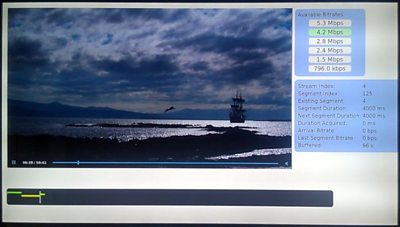Developing and standardising adaptive bitrate technology to provide audiences with the best possible streaming experience and to minimise unnecessary costs.
Project from 2009 - present

What we are doing
Adaptive bitrate systems aim to deliver the best sound and picture quality achievable using the Internet connection which is available to a viewer at any given time. Such systems can support both live and on-demand media streaming.
The adaptive bitrate system tries to avoid pauses for buffering by selecting a lower quality stream if the Internet connection speed falls, returning to a higher quality stream when conditions improve.
Why it matters
Internet connections in the UK vary widely in the bitrate available for streaming media. At the lower end connections are generally fast enough for stereo sound and a low resolution video picture, with ones at the high end being capable of sustaining full HD video with surround sound. The causes of this variation can be because of both the physical properties of the link, such as distance from the home to the telephone exchange or other termination point, and restrictions imposed on the connection by the ISP, such as a bitrate limit for certain types of traffic.
For the Βι¶ΉΤΌΕΔ, this variety of Internet connection speeds could lead to a trade-off between reach – what proportion of our audience can receive our service – and quality. This is further complicated by the short term variations which could cause playback to stall on an otherwise fast connection.
Connection quality can vary dramatically at different times of the day due to:
- Network congestion within the Internet Service Provider
- Other people in the home using the Internet connection
- Interference on Wi-Fi networks or between the home and telephone exchange
Obviously we want to reach all of our audiences without sacrificing quality. Adaptive bitrate systems allow us to provide the best possible for each viewer. Where connection speeds are high then the best quality streams can be used, but where speeds are limited lower bitrate streams can be used.
Our Goals
Our vision is of a single adaptive bitrate standard which we can use to target all platforms and devices for media streaming. This will enable the benefits mentioned above and reduce our costs through economies of scale, avoiding duplicate workflows to target different consumer equipment.
In terms of requirements for an adaptive bitrate system we consider the following to be essential:
- Support for live and on-demand content
- Ability to reuse media across different devices – ideally using just one version per bitrate
- Distribution through commodity infrastructure, typically using HTTP via Content Delivery Networks.
- Cacheability of content.
- Bitrate selection at the client with no state held by the server for scalability.
- Support for access services, such as subtitling and audio description.
- Minimal overhead introduced by the bitrate selection system
In some respects, the Βι¶ΉΤΌΕΔ operates in a more demanding environment than many other content providers. We can experience very high demand for streams, usually during major sporting events or incidents which generate significant new coverage, and we can have high instantaneous demand to start a stream when there is a call-to-action on a broadcast channel. These mean that our ability to make use of caching infrastructure, such as content delivery networks (CDNs), together with control of client side features is very important.
Outcomes
So far during this project we have:
- Developed tools and techniques for producing streams consistent with various standards
- Worked with industry groups including , , and to specify the use of MPEG DASH for streaming to Connected Television devices
- Produced test content to enable development of and compliance testing of connected TV devices
- Established simulations to allow the development of client algorithms. Such algorithms are used to control how the client decides which bitrate to use at any given time.
- Created test environments in which we can demonstrate adaptive bitrate systems end to end.
Project Team
-

Broadcast and Connected Systems section
Broadcast & Connected Systems primarily focuses on how Βι¶ΉΤΌΕΔ content reaches our viewers through broadcast and Internet delivery. This involves the whole broadcast chain from playout, through coding and distribution to consumption on the end-user's device. Our work typically covers a period from now through to 3 years out from deployment.
